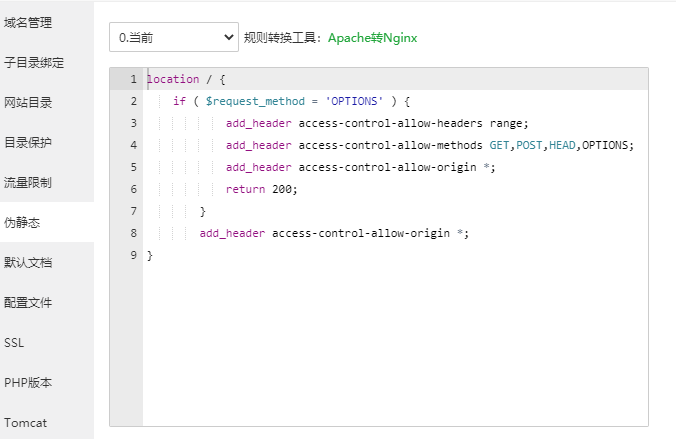日志配置
日志对于统计排错来说非常有利的。本文总结了nginx日志相关的配置如access_log、log_format、open_log_file_cache、log_not_found、log_subrequest、rewrite_log、error_log。
nginx有一个非常灵活的日志记录模式。每个级别的配置可以有各自独立的访问日志。日志格式通过log_format命令来定义。
ngx_http_log_module是用来定义请求日志格式的。
1. access_log指令
语法:
access_log path [format [buffer=size [flush=time]]]; access_log path format gzip[=level] [buffer=size] [flush=time]; access_log syslog:server=address[,parameter=value] [format]; access_log off;
默认值: access_log logs/access.log combined;
配置段: http, server, location, if in location, limit_except
gzip压缩等级。
buffer设置内存缓存区大小。
flush保存在缓存区中的最长时间。
不记录日志:access_log off;
使用默认combined格式记录日志:access_log logs/access.log 或 access_log logs/access.log combined;
2. log_format指令
语法: log_format name string …;
默认值: log_format combined “…”;
配置段: http
name表示格式名称,string表示等义的格式。log_format有一个默认的无需设置的combined日志格式,相当于apache的combined日志格式,如下所示:
log_format combined '$remote_addr - $remote_user [$time_local] ' ' "$request" $status $body_bytes_sent ' ' "$http_referer" "$http_user_agent" ';
如果nginx位于负载均衡器,squid,nginx反向代理之后,web服务器无法直接获取到客户端真实的IP地址了。 $remote_addr获取反向代理的IP地址。反向代理服务器在转发请求的http头信息中,可以增加X-Forwarded-For信息,用来记录 客户端IP地址和客户端请求的服务器地址。
log_format porxy '$http_x_forwarded_for - $remote_user [$time_local] ' ' "$request" $status $body_bytes_sent ' ' "$http_referer" "$http_user_agent" ';
日志格式允许包含的变量注释如下:
$remote_addr, $http_x_forwarded_for(反向) 记录客户端IP地址 $remote_user 记录客户端用户名称 $request 记录请求的URL和HTTP协议 $status 记录请求状态 $body_bytes_sent 发送给客户端的字节数,不包括响应头的大小; 该变量与Apache模块mod_log_config里的“%B”参数兼容。 $bytes_sent 发送给客户端的总字节数。 $connection 连接的序列号。 $connection_requests 当前通过一个连接获得的请求数量。 $msec 日志写入时间。单位为秒,精度是毫秒。 $pipe 如果请求是通过HTTP流水线(pipelined)发送,pipe值为“p”,否则为“.”。 $http_referer 记录从哪个页面链接访问过来的 $http_user_agent 记录客户端浏览器相关信息 $request_length 请求的长度(包括请求行,请求头和请求正文)。 $request_time 请求处理时间,单位为秒,精度毫秒; 从读入客户端的第一个字节开始,直到把最后一个字符发送给客户端后进行日志写入为止。 $time_iso8601 ISO8601标准格式下的本地时间。 $time_local 通用日志格式下的本地时间。
[warning]发送给客户端的响应头拥有“sent_http_”前缀。 比如$sent_http_content_range。[/warning]
实例如下:
http { log_format main '$remote_addr - $remote_user [$time_local] "$request" ' '"$status" $body_bytes_sent "$http_referer" ' '"$http_user_agent" "$http_x_forwarded_for" ' '"$gzip_ratio" $request_time $bytes_sent $request_length'; log_format srcache_log '$remote_addr - $remote_user [$time_local] "$request" ' '"$status" $body_bytes_sent $request_time $bytes_sent $request_length ' '[$upstream_response_time] [$srcache_fetch_status] [$srcache_store_status] [$srcache_expire]'; open_log_file_cache max=1000 inactive=60s; server { server_name ~^(www.)?(.+)$; access_log logs/$2-access.log main; error_log logs/$2-error.log; location /srcache { access_log logs/access-srcache.log srcache_log; } } }
3. open_log_file_cache指令
语法:
open_log_file_cache max=N [inactive=time] [min_uses=N] [valid=time]; open_log_file_cache off;
默认值: open_log_file_cache off;
配置段: http, server, location
对于每一条日志记录,都将是先打开文件,再写入日志,然后关闭。可以使用open_log_file_cache来设置日志文件缓存(默认是off),格式如下:
参数注释如下:
- max:设置缓存中的最大文件描述符数量,如果缓存被占满,采用LRU算法将描述符关闭。
- inactive:设置存活时间,默认是10s
- min_uses:设置在inactive时间段内,日志文件最少使用多少次后,该日志文件描述符记入缓存中,默认是1次
- valid:设置检查频率,默认60s
- off:禁用缓存
实例如下:
open_log_file_cache max=1000 inactive=20s valid=1m min_uses=2;
4. log_not_found指令
语法: log_not_found on | off;
默认值: log_not_found on;
配置段: http, server, location
是否在error_log中记录不存在的错误。默认是。
5. log_subrequest指令
语法: log_subrequest on | off;
默认值: log_subrequest off;
配置段: http, server, location
是否在access_log中记录子请求的访问日志。默认不记录。
6. rewrite_log指令
由ngx_http_rewrite_module模块提供的。用来记录重写日志的。对于调试重写规则建议开启。 Nginx重写规则指南
语法: rewrite_log on | off;
默认值: rewrite_log off;
配置段: http, server, location, if
启用时将在error log中记录notice级别的重写日志。
7. error_log指令
语法: error_log file | stderr | syslog:server=address[,parameter=value] [debug | info | notice | warn | error | crit | alert | emerg];
默认值: error_log logs/error.log error;
配置段: main, http, server, location
配置错误日志。
——————————————————————————–
日志切割
nginx日志默认情况下统统写入到一个文件中,文件会变的越来越大,非常不方便查看分析。以日期来作为日志的切割是比较好的,通常我们是以每日来做统计的。下面来说说nginx日志切割。
1. 定义日志轮滚策略
# vim nginx-log-rotate
/data/weblogs/*.log { nocompress daily copytruncate create notifempty rotate 7 olddir /data/weblogs/old_log missingok dateext postrotate /bin/kill -HUP `cat /var/run/nginx.pid 2> /dev/null` 2> /dev/null || true endscript }
[warning]/data/weblogs/*.log使用通配符时,/data/weblogs/目录下的所有匹配到的日志文件都将切割。如果要切割特定日志文件,就指定到该文件。[/warning]
2. 设置计划任务
59 23 * * * root ( /usr/sbin/logrotate -f /PATH/TO/nginx-log-rotate)
这样每天23点59分钟执行日志切割。
以上就是本文的全部内容,希望对大家的学习有所帮助,也希望大家多多支Fatmouse















暂无评论内容